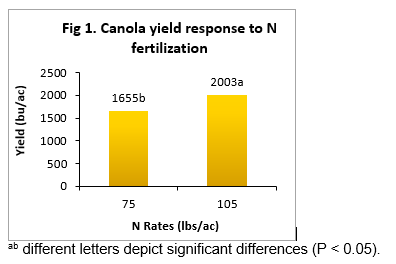Introduction
Nitrogen (N) and sulfur (S) fertilizers are vital in canola production. Farmers in the Northern Great Plains have long been interested in strategies to enhance the efficient use of these fertilizers. These strategies, which include split application of N, application timing, and use of enhanced efficiency N fertilizers (EENFs), have not been widely adopted because of inconsistencies in their impact on canola productivity. While it is a common practice to apply S fertilizer all at planting, some European studies have recommended application of S at bolting to maximize canola uptake and use efficiency.
Objectives
- Assess whether canola yield response to split N fertilization varies with rate of S.
- Compare the yield response from N top-dress with SuperU (EENF) versus conventional urea.
- Assess whether S application at bolting will enhance canola yield versus preplant fertilization.
Methods
The trial was conducted at Carrington. There were 18 fertilizer treatments consisting of nine N treatments at 15 lbs S, and the same N treatments at 30 lbs S. Soil N was 45 lbs at Carrington.
- Treatments 1-4: Two N rates at 120 lbs and 150 lbs N each fertilized with 15 or 30 lbs S.
- Treatments 5-12: Six split N treatments; urea was applied at 35 lbs and 65 lbs N/ac; three plots were top-dressed with urea and the other three with SuperU at 40 lbs N. S rates were 15 and 30 lbs.
- Treatments 13 to 18: compared different split urea N rate combinations (105/0, 65/40, 45/60 lbs N) for a total N application of 105 lbs/ac at 15 lbs S and 30 lbs S that was applied at bolting.
Results
Average yield was significantly greater at 105 lbs N compared to 75 lbs N/ac (Fig 1). Yields were not significantly different between 15 and 30 lbs S, which was likely due to soil S availability during the growing season. This probably explains why yields were not different between treatments that received S fertilizer before planting and those that only received S at bolting.
Yields were neither different between split N application and single application as a starter, nor were they different between the different amounts of starter N. Yields from N top-dress with urea were also not different from yields with SuperU top-dress. Prolonged drought that lasted about one week during bolting stage, when N was top-dressed (on dry topsoil), may not have resulted in an important loss of N from urea compared to SuperU, thus explaining the lack of yield impact.
Conclusion
Yields were improved by 105 lbs N, which is the NDSU recommendation rate. There was no impact of split-N application, S application at planting versus at bolting, and no yield differences between 15 and 30 lbs S. Nonetheless, the canola S recommendation of 25 or 30 lbs is the best option for farmers to ensure S is not deficient for the crop. More studies are needed to determine if less S may be needed when low preplant N rates are applied.

